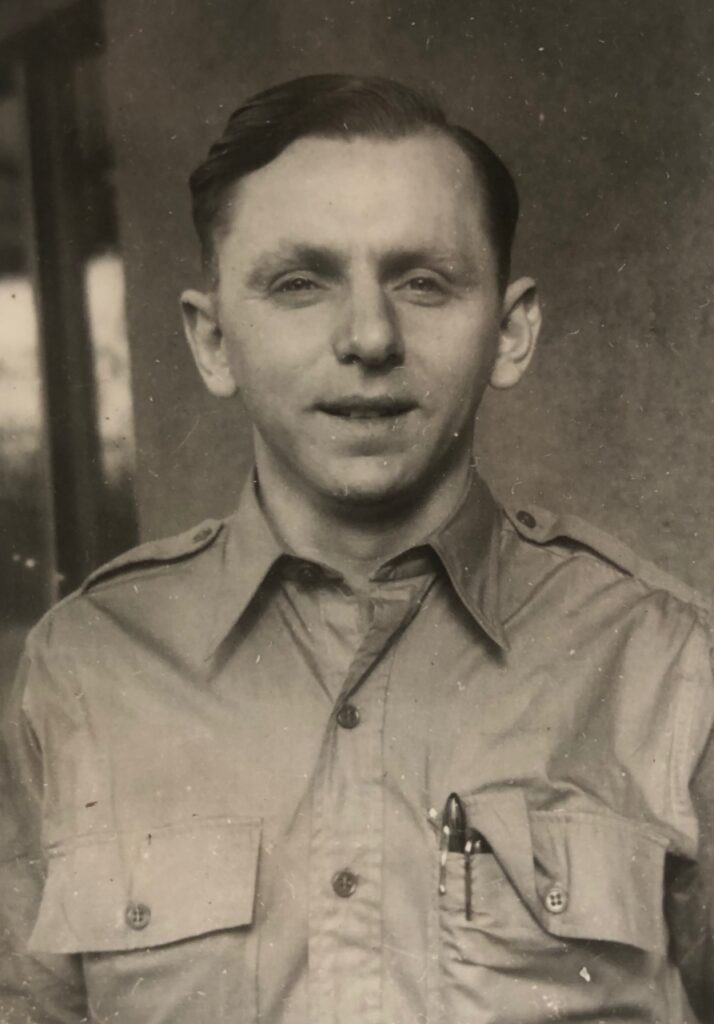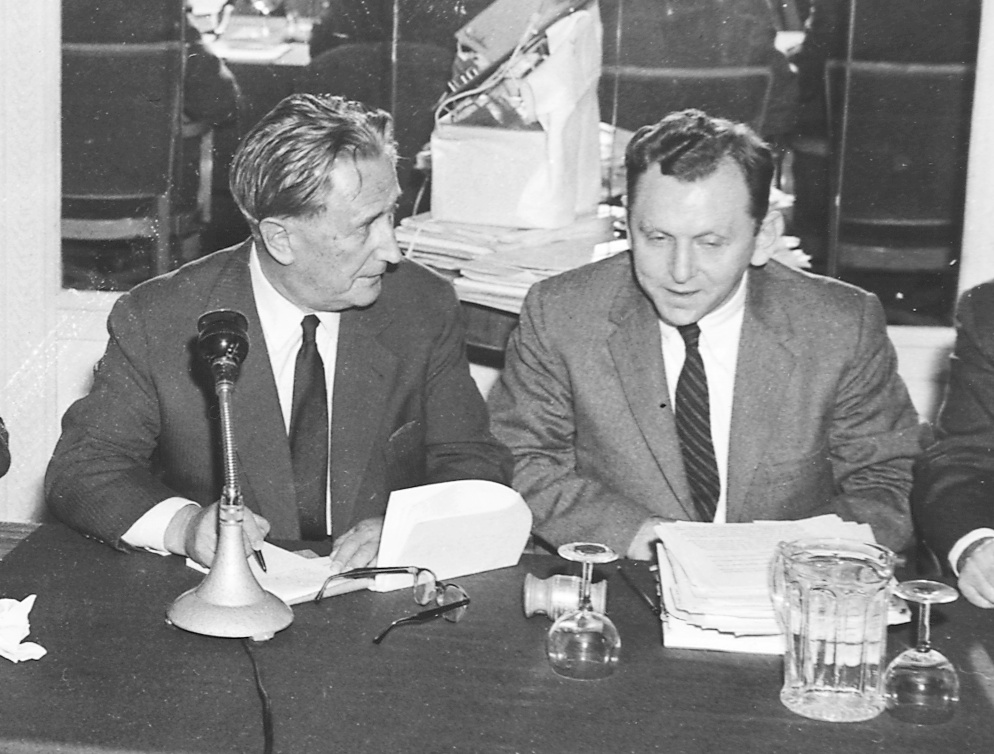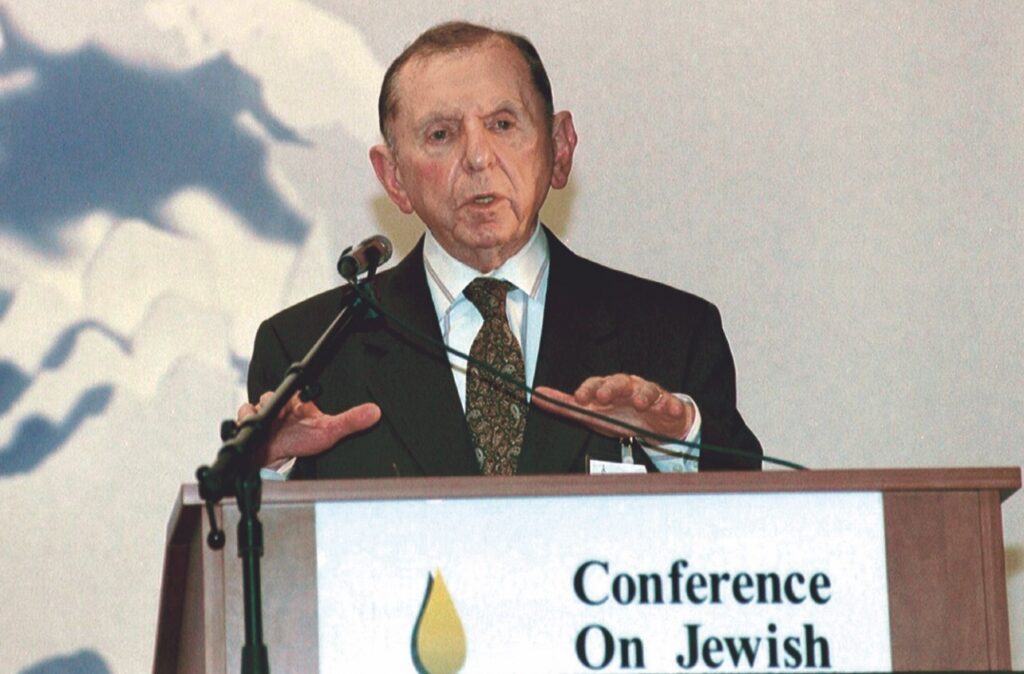Saul Kagan z”l, was the architect of Holocaust compensation and restitution. He made it his life’s calling to attain a small measure of justice for those Jews who had managed to survive the Shoah, and in so doing, became the backbone of an unparalleled historic endeavor.
Life During World War II
Saul Kagan left Vilna, Lithuania in 1940 and traveled by trans-Siberian railroad to Vladivostok. From there, he took a boat to Japan, waited a month, traveled by boat to Hawaii, then San Francisco, and then by train to relatives in New York.
In 1941, Mr. Kagan’s father, the managing director of the Vilna Jewish hospital, received permission to go to Sochi for treatment for his ulcers. While gone, Hitler invaded the USSR. His father could not get home, was made to go to Tashkent, and survived the war in the Asian part of the USSR. Mr. Kagan’s mother, brother, and grandparents were all killed by the Nazis.
Mr. Kagan’s father made his way to Vilna in 1946, found no family remaining, married a widow and left with her for Stockholm where he died in1964.
In the U.S., Saul joined the U.S. Air Force and as part of a special intelligence unit he provided close air support to U.S. infantry. Mr. Kagan also landed at Normandy three days after D-Day and he was at the famous Battle of the Bulge.
After the war, Mr. Kagan was a colonel in the U.S. military government in Berlin and chief of financial intelligence, reporting on the role of the German banking system in financing the war and on the confiscation of Jewish property in Germany. The information Mr. Kagan discovered was later used in the Nuremberg Trials.
In 1947, Mr. Kagan was directly involved in the creation of U.S. Government Military Order #59, which dictated that Holocaust survivors or families of victims could file claims for property confiscated by the Nazis. Mr. Kagan was asked to create the first asset restitution body, the Jewish Restitution Successor Organization.


The Architect of Holocaust Restitution
Saul Kagan spent his entire adult life working tirelessly for the rights of Holocaust victims. He single-mindedly pursued the goal of obtaining a small measure of justice for those who suffered without measure. Mr. Kagan’s efforts resulted in the unparalleled historic endeavor of compensation and restitution for Holocaust victims from Germany, Austria and other entities.
He did not wait for history to present opportunities; he made history. There are survivors the world over who did never and will never know the name of Saul Kagan, but his work helped them live out their lives with an added measure of dignity.
Mr. Kagan was guided by the rebuke of the prophet Elijah to King Ahab (Kings I), whose wife Jezebel had engineered the death of Naboth so Ahab could take possession of his vineyard: “Would you murder and also inherit?”
Negotiations with Germany
Mr. Kagan was a giant of Holocaust compensation and restitution, but never sought any credit for himself. His work was always about making something happen, finding the way through, solving the problem – it was never about him. All that mattered was that the cause was right and that the result would benefit those who needed the most.
And those results were significant: $70 billion paid in pensions by Germany directly to survivors as a result of negotiations in the 1950s. Another $6 billion paid by the Claims Conference in additional programs created since 1980. There have been constant negotiations to expand compensation programs and include additional survivors, whose experiences deserved to be acknowledged with payments.
These negotiations included talks with Erich Honecker in 1987 about the obligation of the German Democratic Republic (East Germany) to Holocaust victims. The talks did not result in any agreements, but showed Mr. Kagan’s conviction that Germany’s obligation to Nazi victims should continue to be addressed.
Photo: Rabbi Israel Miller, Claims Conference President, and Saul Kagan, Executive Vice President, right, meeting with Erich Honecker, left, Chairman of the Council of State of East Germany, in 1987


The Struggle for Material Compensation
Mr. Kagan was instrumental in negotiating with the government of the newly unified Germany in 1990 to allow Jewish owners and heirs to file claims for properties that had lain inaccessible in East Germany for decades. He also pushed for the right of the Claims Conference to recover any Jewish properties that went unclaimed, so that they should not revert back to the state or wartime non-Jewish owners.
The sale of these recovered properties provided enough revenue to fund far more than $1 billion in vital social services to Holocaust victims worldwide, including hunger relief, homecare, medical aid, and other assistance needed by aging, frail survivors.
Beginning in 2004, Claims Conference negotiations with the German government have also led to approximately $1.6 billion in funding through 2017 for homecare for elderly Nazi victims around the world. These negotiations have been based on the premise that Germany had an obligation to ease the old age of those who its country so grievously wronged in their youth.
Mr. Kagan also helped spearhead decades of negotiations with the government of Austria, ceaselessly pushing to compel that country to recognize its historic role in the Holocaust and the persecution of its Jews. Austria’s contention that it was the “first victim” of Hitler did not appease Mr. Kagan and his fellow negotiators, who knew that Austrians gladly welcomed the Nazis and willingly participated in disenfranchising the country’s Jews. In 2001, after several smaller agreements over the decades, Austrian government and industry agreed to a $500 million compensation and restitution agreement for the country’s Jewish survivors, brokered at the U.S. State Department in the last few days of the Clinton Administration.
Photo: Saul Kagan, Claims Conference Special Consultant and former Executive Vice
President and Chairman Julius Berman visit with a survivor at her home in
Jerusalem. Photo: Sasson Tiram
At the Claims Conference
Mr. Kagan became executive director of the Claims Conference when it was established in 1951 and made it his life’s calling to bring a small measure of justice to Jewish victims of the Holocaust and care for those in need around the world. When discussing the historical imperative behind the Claims Conference’s mission, Mr. Kagan would refer to the Nazi effort to eradicate a Jewish presence in Europe as “a thousand-year history destroyed in 12 years.”
David Ben-Gurion said in a 1952 letter to the Claims Conference’s first president, Nahum Goldmann, “For the first time in the history of the Jewish people, oppressed and plundered for hundreds of years…the oppressor and plunderer has had to hand back some of the spoil and pay collective compensation for part of the material losses.”
During his six decades with the Claims Conference, Mr. Kagan’s memory for details of agreements and negotiations was flawless. He could be asked a question about any agreement in which he had participated and provide not only details but historical context and the names of key players in the talks. He spoke six languages.
Just as the genocide against the Jews was unparalleled in human history, the work of the Claims Conference too is without parallel. While its efforts can never restore those who perished or begin to compensate for the victims’ suffering, the Claims Conference has brought about Germany’s acknowledgement of its crime and the restitution not only of assets, but the restitution of history. Throughout, Saul Kagan has been the organization’s conscience, historian, and champion of those who suffered beyond measure.

